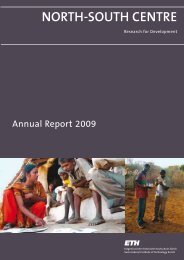Annual Report 2006/07 - ETH - North-South Centre North-South ...
Annual Report 2006/07 - ETH - North-South Centre North-South ...
Annual Report 2006/07 - ETH - North-South Centre North-South ...
You also want an ePaper? Increase the reach of your titles
YUMPU automatically turns print PDFs into web optimized ePapers that Google loves.
ZIL research projectsLivestocksystemsresearchFeeding strategiesFood quality and public healthZIL research project, Phase VProject leadersMichael Kreuzer, Andrea MayerContact personAndrea MayerCollaboratorsLuis Iñíguez, Barbara Rischkowsky, SafouhRihawi, Muhi El-Dine Hilali, Aden Aw-Hassan,Asamoah Larbi, ICARDA, Syria / ChristopheLacroix, Bernard Lehmann, Martin Scheeder,<strong>ETH</strong> Zurich / Hans-Dieter Hess, ALPDurationOctober 2003 – May 20<strong>07</strong>Improving small ruminant productivity in dry areasthrough cost-efficient animal nutrition and improvedquality of milk and dairy productsIn dry areas, small ruminant production contributes substantiallyto the livelihood of small-scale and resource-poor farmers.A common limiting factor to all arid regions is feed scarcity.Farmers try to include non-conventional feeds, e.g.by-products of the food industry, and attempt to integratecropping and livestock activity, e.g. by making use of cropresidues. This ZIL project develops new, participatory andWoman milking Awassi sheep in the El-Bab region of SyriaAwassi sheep feeding on olive branches, which were collected bylivestock farmers for their animals after olive tree pruning in Autumnmarket-oriented approaches to improve resource use efficiencyand productivity and profitability of small ruminantproduction systems, in particular fat-tailed Awassi sheep, indry areas by more cost-efficient feeding, enhanced milk quality,and increased farmers’ income.In order to get an overview on the feeds actually used by thefarmers, feed markets were visited in Autumn <strong>2006</strong> and asurvey was conducted with 30 farmers in the El-Bab region ofSyria. A master student will analyse the importance of qualityissues in the market chain of dairy products. In Octoberand November 20<strong>07</strong>, two digestibility experiments will becarried out at ICARDA, Syria, in order to assess intake,digestibility and nitrogen balance of eight diets (olive leaves,lentil straw, vetch hay and Atriplex halimus leaves as foragetypefeeds, and olive cake, tomato pulp, molasses/sugar beetpulp and broken lentil as concentrate-type feeds) comparedto a traditional control diet. In order to assess the influenceof the different feeds on the whole system, the effect of thefaeces of the experimental animals on certain soil propertieswill be tested in an additional soil experiment. Based on theresults of the digestibility experiment, five diets will beselected for a subsequent feeding experiment with Awassiewes in order to determine the response in milk productionand milk and dairy product quality (e.g. cheese and yogurtquality). In an on-farm experiment, two of the best dietsidentified based on the ewes experiment will be tested onfarmin close collaboration with farmers. Applying Life CycleAssessment (LCA), the ecological sustainability of certainfeeding options will be tested.38
















